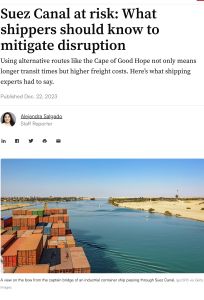
Suez Canal at risk: What shippers should know to mitigate disruption
Using alternative routes like the Cape of Good Hope not only means longer transit times but higher freight costs. Here’s what shipping experts had to say.
Recommendation
With the advent of Houthi attacks on ships traversing shipping lanes in the Red Sea to the Suez Canal, some major carriers rerouted their cargo ships by way of South Africa’s Cape of Good Hope. Carriers that take this alternate route suffer additional costs and transit times. The trip from Asia to Europe around the Cape is 3,500 kilometers (2,175 miles) longer than the journey through the Suez Canal and costs an additional $500,000 to $1 million in fuel, as well as other expenses, such as insurance. As a result, delivery will be slower, shippers must hold inventory longer and shipping rates will inevitably increase.
Summary
About the Author
Alejandra Salgado is a staff reporter for Supply Chain Dive. Before joining Industry Dive, she interned at CNBC, Bloomberg and Long Beach Local News.
















Comment on this summary